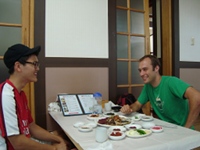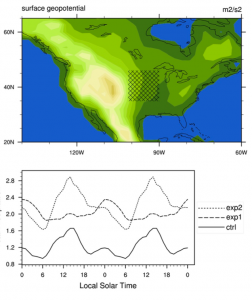During the summer of 2011 I participated in the East Asia and Pacific Summer Institutes (EAPSI) program in South Korea. I worked with Professor Myong-In Lee at the Ulsan National Institute of Science and Technology (UNIST). I met a lot of great people and ate some amazing food! I would strongly encourage any fellow PhD students to consider applying for EAPSI.
The aim of my project was to consider the claim made by several papers that convective entrainment should be large in the lowest part of a cloud and decrease with height. Del Genio and Wu (2009) found evidence for this and showed how entrainment may help regulate the timing of diurnal precipitation. I was able to impose this condition in a convection scheme and tested several variations in a single column atmospheric model. Although I was unable to demostrate the effect of this modification in the single column model, after returning from Korea I implemented this same scheme in a global atmospheric model and produced some interesting results.
Specifically, the nocturnal precip maximimum that is observed over the US Great Plains during boreal summer (Jun-Aug) was captured in the model only when entrainment was biased towards the lower levels. The figure to the left illustrates this result. The terrain used by the model is contoured in the upper panel, and the hashing indicates the area over which the composite diurnal cycle is calculated in the lower panel. The solid curve shows the control simulation with no changes to the cumulus scheme. The dashed curve (i.e. exp1) shows the effect of the modification with the highest precip occuring after midnight (local time). The dotted curve shows a different modification designed to validate that the behavior seen in exp1 is in fact due to entrainment being highest in the lower portion of each cloud.
I extended this analysis to look at the diurnal variability in other parts of the globe, such as over the amazon basin during austral summer, but the results were mixed. I have also used these simulations to analyze how the simulation of the MJO is affected. The analysis has shown that this same modification produces a more focused spectral peak in the intraseasonal band where the MJO should reside, but also reduces spurious low-frequency variable outside the intraseasonal band that is not observed in nature. After more thorough analysis I found a problem in which there was too much ice in the upper troposphere, which really messed up the radiative feedbacks. I’m not positive about this, but I think it is a direct consequence of having large entrainment at cloud base and only detraining at cloud top.






